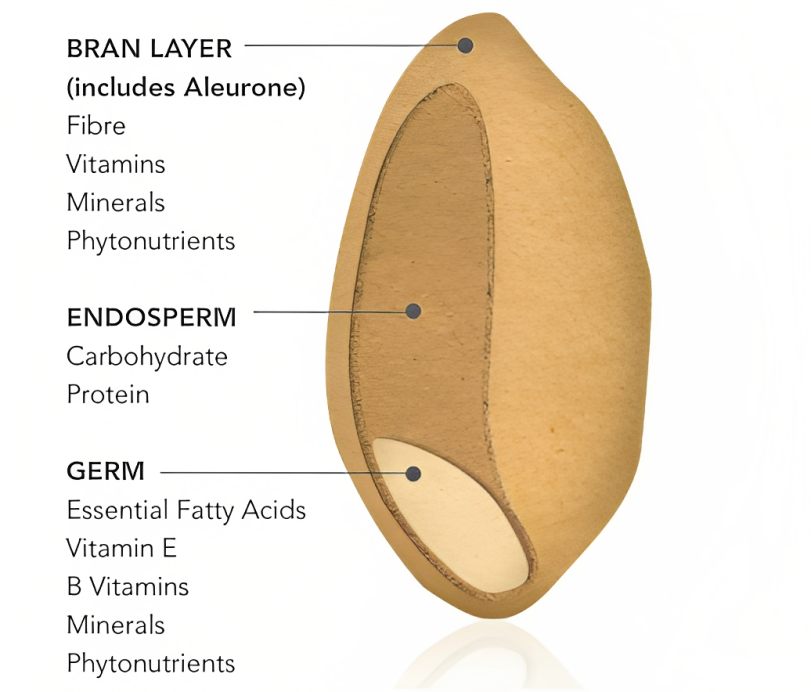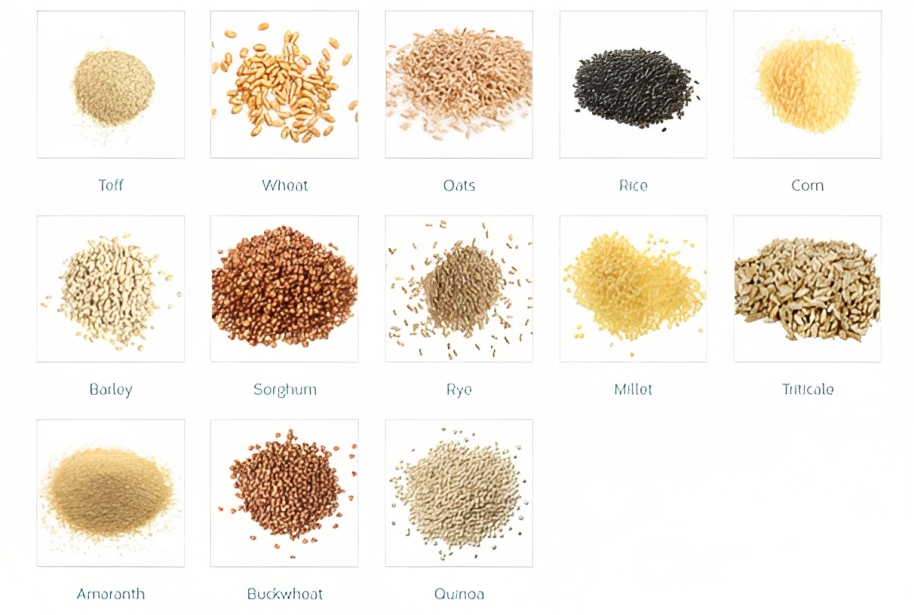Cereal grains are the world’s single biggest source of food energy. The three most commonly consumed types are wheat, rice and corn. Despite widespread consumption, the health effects of grains on our digestive system are quite controversial. Some think they are an essential component of a healthy diet, while others think they cause harm. Commonly Grains consist of three important parts:
- The bran (the outermost layer), which contains fibre and B vitamins.
- The germ which contains oils, vitamins, proteins, minerals, and antioxidants.
- The endosperm (located above the germ), which contains carbohydrates and protein.

Types of Grain:

Grain foods are typically categorized either as whole or refined.
- Whole grains are grains that have been minimally processed to still contain the bran, germ, and endosperm, whereas refined grains only contain the endosperm. The endosperm makes up about 85 percent of a wheat grain, meaning that just 15 percent of the grain contains all of its fibre and most of its nutrients.
- Refined grains can come from the same plant as whole grains, they’re just missing the germ, bran, and all the nutrients that go along with them. They have a longer shelf life than whole grains, since the oily germ tends to become rancid when exposed to light and heat.
- Whole grains offer vitamins, minerals, and antioxidants that have many potential health benefits. For example, replacing refined grains with potassium-rich whole grains may help lower blood pressure. The dietary fibre in whole grains slows digestion, which makes them low on the glycemic index. High-glycemic-index foods (like refined grains) can be digested very quickly, causing sharp spikes in blood sugar that can increase the risk of type 2 diabetes and heart disease.
Popular Grains and their effects:
- Wheat: is the most widely cultivated cereal crop in the world. Wheat has come to be a firm favourite grain because of the diversity it provides in culinary applications. Relatively high in protein (11-13%) compared with other major grains and contains a protein complex which forms gluten. High in potassium and low in sodium. Contains B-group vitamins such as thiamine, riboflavin, niacin, vitamin B6 (pyridoxine), folate and pantothenic acid. It also Contains vitamin Contains iron, zinc, magnesium, phosphorus and selenium (depending on the soil content of selenium). Contains small amounts of copper, manganese and calcium. Wheat contains protein called gluten which some people are sensitive to. Celiac disease is an allergy to wheat gluten that causes an abnormal immune system reaction in the intestines. Wheat allergy is when the body produces antibodies to the proteins in the wheat. Try eliminating gluten from your diet and note if your symptoms improve.
- Rice: is the staple grain which is used all over India in different forms. White rice is a bland, low-fibre food because it is processed, like white flour and bread. White rice is easy on your digestive system, making it a suitable item on bland menus for people recovering from various digestive system ailments like an upset stomach, gastroenteritis and diverticulitis. Brown rice is a high-roughage food rich in insoluble fibre on its outer part, with soluble fibre inside. The soluble fibre controls blood sugar and lowers cholesterol, but the insoluble fibre promotes good digestion. Unlike the soluble type, which changes its form into a jelly, the insoluble type retains its shape and resists digestion. This allows it to move other digestible foods along more efficiently. The insoluble fibre also absorbs water that moisturizes stool, and it bulks up your waste product into soft but solid pieces. Combining rice with dal makes a complete protein which is good if taken in limited quality in evening also.
- Jowar (Sorghum): Sorghum is one of the most commonly used cereal grains in the world and a lot of that is thanks to the rich nutritional value it offers to the consumer. Sorghum is found to be rich in vitamins and minerals, along with providing great protein content and making up for a large portion of your dietary fibre intake. Nutritional composition of sorghum includes calcium, iron, phosphorous, potassium and sodium are found in the quantities of 53.8 mg, 8.4 mg, 551 mg, 672 mg and 11.5 mg respectively per 100 grams sorghum. Vitamins like thiamine, niacin and riboflavin are also found in rich quantities in sorghum. The high dietary fibre content of sorghum makes it one of the best foods in the world for improving digestion and taking care of the digestive system. A single serving of sorghum can contain up to 48% of a person’s recommended daily intake of dietary fibre, which helps the digestive system in keeping the movement of food along with the system completely smooth. Sorghum flour also prevents bloating, cramping, excess gas, constipation, diarrhoea and general stomach aches. The only risk one can probably look out for is the risk of being allergic to the grains, but even such cases are extremely rare. This grain is especially good to have in winters.
- Bajra (Pearl Millet): It’s a widely used millet in India. Its especially popular in winters as it is supposed to keep body warm. It’s a gluten free grain which reduces glucose levels and stabilizes Cholesterol level. High Iron and Zinc content in Bajra helps in increasing haemoglobin. People with iron deficiency Anaemia must include Bajra in their diet to overcome the problem. The lignin and phytonutrients in the bajra act as strong antioxidants thus preventing heart-related diseases. This is why pearl millet is considered good for heart health. High amounts of magnesium present in pearl millet has been shown to control blood pressure and relieve heart stress. Bajra is a good source of energy. They provide protein, fatty acids, minerals, vitamins, dietary fibre, and polyphenols. Typical millet protein contains a high quantity of essential amino acids especially the sulphur-containing amino acids (methionine and cysteine). Bajra is considered the best plant-based protein source. Bajra, when combined with legumes like rajma, moong dal, urad dal, toovar dal, and chana dal, provide complete proteins, especially for vegetarians.
- Ragi (Finger Millet): Finger millet or Ragi is a cereal crop that belongs to the grass family, Poaceae. It is mostly grown in the Karnataka, Andhra Pradesh, Maharashtra, Odisha, Goa, Uttarakhand, and Tamil Nadu. Making of bread, porridge and alcoholic beverages are some ragi powder uses. It is believed to be a great laxative due to its high fibre content and prevents constipation. Even lactating mothers who cannot produce sufficient milk feed it to their babies. Ragi help in reducing weight and treating diseases like diabetes, anaemia, and osteoporosis. It digests very slowly, this makes it good for obese and diabetic patients also contains an amino acid called tryptophan, Methionine, and Lysine. Tryptophan controls your appetite and aids in weight loss. Methionine and Lysine make the skin tissue less prone to wrinkles and sagging. Due to the high content of dietary fibre and polyphenols, it has antidiabetic, antimicrobial, antioxidant properties that prevent tumours and atherosclerosis. Ragi disadvantages are also that it is a rich source of calcium. If consumed in a larger than recommended amount, it can increase the amount of oxalic acid in the body causing kidney stones. Also, Goitrogen present in ragi can interfere with the thyroid hormones and reduce iodine uptake by the thyroid gland. This reduces the levels of iodine in the body. The low iodine levels can lead to goitre. Other than these, People with lactose intolerance and those who cannot have milk can substitute it with ragi. You can have countless recipes that use ragi in delicious forms. From babies to adults, all can have ragi and reap the benefits
- Kuttu (Buckwheat): Kuttu belongs to the group of foods commonly called as pseudo cereals. These are seeds that are consumed as cereal grains but don’t grow on grasses. It’s extremely warm in its potency. This is the prime reason why Kuttu ka Atta (Buckwheat Flour) is not eaten in an everyday meal. Kuttu ka Atta (Buck wheat Flour) can be eaten cooked, baked and roasted and there are many things that can be made out of it. This is the prime reason why the use of buck wheat flour is recommended in winters. In fact, in areas of severe cold, it is regularly consumed as it helps in keeping the body warm internally, thereby reducing the effects of chills and cold and also boosts the internal immunity of the body helping it to fight against external infections and viruses. This whole grain is gluten-free and packed with nutrients like dietary fibre, plant proteins, iron, magnesium, manganese, phosphorus and copper. While buckwheat doesn’t have many vitamins except vitamin B6 and K to speak of, it’s packed with antioxidants and phytochemicals like rutin, quercetin and vitexin. Studies show that if you’re already allergic to latex or rice, you may be allergic to buckwheat too. The symptoms of an allergic reaction to buckwheat include digestive system issues, skin rashes and swelling.
Bottom Line is for majority whole grains are healthy and good for digestion system too. One has to take care that vegetables too are eaten with the whole grains to subside the acidic nature of whole grains in general. People should introduce them to their diet slowly and observe if they have allergy to any specific grain. Wherever possible, prefer grinding the grain and make flour at home and use certain amount for cooking or making roti. Everything is eaten in a proper quantity will always be good, one should not go overboard.

